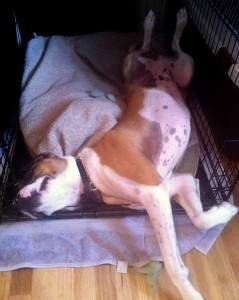Crate Training Your Puppy or Dog
It is always interesting and a bit frustrating to me when I hear people say they think putting their dog in a crate is “mean”. Or when people have a crate trained puppy, but when the dog “gets old enough” they remove the crate from the dogs life. Crates, unless used incorrectly, are a good thing for dogs. They like them and there are benefits for you.
Why Crate Train A Dog or Puppy?

There are lots of reasons to crate train your puppy or dog including:
- Aiding with potty training (see Tips For Housebreaking Your Puppy) – for example, dogs will not generally eliminate in their den and a kennel is a much smaller confined area that a young puppy can conceive of as their den then a room or an entire house.
- Help confine your puppy or dog if she is injured – unfortunately dogs can get injuries or ailments that require they be confined. Being injured or sick is stressful enough for a dog, if they also need to be put in a crate/kennel for the first time in their life that will just add to their stress. However, if the dog sees his crate as his home, then he will naturally want to spend time there when he is not feeling well.
- Keep your house “safe” – in case you don’t know, puppies like to chew and get into things! If they are left to wonder too early in their life they are very likely to do things you consider bad. Of course the puppy is not doing anything bad on purpose, but they don’t yet know the things she is allowed / supposed to do.
- Give your puppy and dog a safe place. To me, this is the most important one. A dog should have a place all their own. A place they can feel safe and not be bothered by other dogs, people, kids, etc. Dogs are den animals, and unless they are introduced to a crate wrong, the crate is a very comfortable den like environment. We recently got a puppy. My adult dog, Joson, liked to play with the puppy, however, sometimes Joson would be done and the puppy would want to keep going. Joson would just go to his kennel to sleep. We, and Joson, taught to the puppy Joson’s crate was a “no go” zone for the puppy.
Get the Right Size Crate
 If the crate is too big for your puppy, she will be more likely to eliminate in some corner of the crate. So you want to get a crate that is small enough to feel like a bed. It is good to get a crate that can expand in size. Lots of crates you buy today will have a separator section where you can grow the area the dog can access as she grows.
If the crate is too big for your puppy, she will be more likely to eliminate in some corner of the crate. So you want to get a crate that is small enough to feel like a bed. It is good to get a crate that can expand in size. Lots of crates you buy today will have a separator section where you can grow the area the dog can access as she grows.
It is even more important to ensure the create is large enough for your dog. Your dog must at least be able to stand up comfortably and turn around.
How to Introduce a Very Young Puppy to a Crate
The crate should be a safe and happy place for the puppy – not punishment.
A New Puppy and Crate May Not Work At First
This can be a challenge. There is a problem with a young puppy – we want to ensure the crate is a safe and happy place, however, when you very first get a puppy, the only “safe and happy place” for the puppy is in your arms. However DO NOT let the puppy sleep in your bed with you! Often the first couple nights with a puppy are crucial for getting the dog to be comfortable away from you, and they are going to be a bit sleepless for you and the puppy! Just understand that and prepare for it. If you get a brand new puppy (e.g. 8 weeks old or so) the first night with you is very likely his first night away from his siblings and he is going to be lonely and he will not understand what is going on.
In a perfect world, he would already be used to a crate, but that is not always the case (in fact, it is rarely the case). But you also have to sleep. With every puppy I have had, they go in a box or other confinement (not a dog crate) next to my bed. Often I will put my hand or arm in the box so they know I am there if he cries, then I remove my arm (all night long). Don’t be too doting or coddle with your puppy. This will only reinforce the behavior and he’ll cry even more. If he continues to whine, a gruff “Quiet” and a quick, but gentle, shake by the scruff should settle the matter. If all else fails, ignore him. Tough love may be difficult, but eventually your puppy will learn that crying at night gets him nowhere. The more persistent you are in your approach, the quicker the situation will be resolved. If you’re stern one minute and sympathetic the next, your puppy will only be confused and his behavior will continue. This only usually lasts for 2 nights.
You must also consider if the cry is for attention or because he needs to go potty. If the later, I get up and take him out quickly (do not play with him or give too much attention). Puppies have small bladders and need to go out often – every 2 to 4 hours. Remember to take away food and water at about 7:00 in the evening so that he is running on empty at bedtime. Oh, and take him out before bed!
Some people say a radio or other soft noise will help – and it can depend on the puppy. I have also seen where wrapping a ticking clock (an old analog alarm clock) in a towel and putting that in the box helps.
Don’t forget to let the puppy outside to go potty first think in the morning!
Okay, Graduate to the Crate
I use a box during the first nights because I always want the crate to be a safe happy place. You need to set aside time over the first few days to work on the crate so the dog can graduate from the box as soon as possible. Do this by:
- Leaving the door open, put a treat in the crate, and let the puppy go in and retrieve the treat – don’t close him in. Do this throughout a day.
- Next put the treat in and keep the puppy in the crate with your hand. Again, if he does cry, wine or bark, wait for a few seconds of calm before letting him out. But if you do this correctly and slowly the puppy should be fine with it.
- Finally, start to put the treat in and close the door for just a moment and then let him out. Again, if he does cry, wine or bark, wait for a few seconds of calm before letting him out. But if you do this correctly and slowly the puppy should be fine with it. Slowly increase how long you shut the door for.
How to Introduce an Older Puppy or Dog to a Crate
It is the same as with a puppy but hopefully without the nighttime drama as he should be used to sleeping through the night now so you don’t need the box. If the dog has had a bad experience with a crate it may take more time and patience.
What NOT to Use a Crate For
 A crate should not be used for punishment! It should be a place the puppy or dog want to go and will go to on their own. Not only will punishment make them not like the crate, it is pointless as a dog does not understand punishment. They do understand when you are mad, when they are scared, etc. But punishment only scares them. It is much better to redirect energy and train your dog. You and the dog will be happier and have a much better relationship. Lots of people think they can punish the dog because the “dog knows he did something wrong, he looks guilty”. There has been a lot of research on this subject, and everything I have seen and read shows that dogs do not feel guilt. They do feel fear and some are very good at sensing when their owners are unhappy.
A crate should not be used for punishment! It should be a place the puppy or dog want to go and will go to on their own. Not only will punishment make them not like the crate, it is pointless as a dog does not understand punishment. They do understand when you are mad, when they are scared, etc. But punishment only scares them. It is much better to redirect energy and train your dog. You and the dog will be happier and have a much better relationship. Lots of people think they can punish the dog because the “dog knows he did something wrong, he looks guilty”. There has been a lot of research on this subject, and everything I have seen and read shows that dogs do not feel guilt. They do feel fear and some are very good at sensing when their owners are unhappy.
Also, do not teach the dog to go to the bathroom in the crate – e.g. don’t put potty pads in the crate. If you do this, and the dog learns to eliminate in his crate, you are going to have a much more difficult time housebreaking your dog! Understand when you get a puppy you need to figure out a schedule to let the dog out every few hours for the first couple months.
